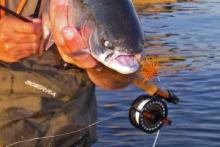Baltic flies for calm and clear water
In this part of the series on different coastal conditions, we look at a common situation: water clear as gin and maybe even calm as a mirror. Not the easiest of fishing conditions, but adapting gear and flies to the situation helps.
Coastal sea trout can be hunting even in the clearest and calmest water. When that is the case, stealth is the key, and you will often be fishing for fish quite close to you, and not rarely cast to fish that you have seen. The fly needs to be discrete and able to land softly, and a long thin leader in combination with a small and neutral fly can often be the key to success.
And presentation… presentation!
Your fly must land so gently at the end of a fully stretched leader and tippet as if you were fishing the smallest dry fly on the clearest chalk stream of your imagination.
Adapt
A lot of people seem to think that clear and calm coastal water is devoid of fish, but that is not the case. I have the statistics of my fishing friends and myself to prove the opposite. We have logged many fish from water that laid like a mirror, and giving up because there are no waves or even riffles makes little sense. For some a calm and sunny day with a mirror surface and clear water spells no fishing.
But I beg to differ!
You just have to adapt.
It might be difficult to fish, requiring precise and delicate casts with long and thin leaders – with the added disadvantage of having no wind to help – but the fish are often there, and even visible in the clear and calm water. You will often find such conditions late summer and autumn, where the fish are even full from a whole summer of eating, and not exactly falling for any bushy or flashy fly, presented clumsily in a pile of fly line and leader, splashing in the calm and clear water.
Our stats tell us that fishing in these conditions can be very productive, and it's also comfortable.
So don't let calm water keep you from fishing. Extend your leader a bit, go down a tippet size or two, consider using a light Weight Forward line rather than a heavy shooting head, and arm yourself with some calm water flies.
Calm water tactics
Fishing in calm and clear water requires some finesse. The popular tactic where you simply search the water by casting and walking along the beach in the water might not be very efficient, because the water is so undisturbed, that a line or even a leader and a large fly landing, will not lure the fish, but more likely spook them.
It's a common belief that Baltic sea trout are somewhat stupid hunters that will attack almost anything that moves. That can be true, and under some circumstances the fish will throw themselves upon any fly presented close enough for them to spot it. If they miss you can cast again, and you can overline fish, splash, cast shadows and make a lot of “noise” and still you will be able to hook a fish.
But most times when the water is clear and calm, the fish are actually very spooky and alert, and the way to increase your “luck” is to be discreet and attentive.
Don’t splash
Approach the water carefully. Oftentimes sea trout are prowling in very shallow water and in what is known as the trough behind the sand bar closest to the shore. These fish can be covered from land – and should be – and when you do so, stay low. Like any fish, sea trout also react to movement on the bank and shadows moving over them.
When you enter the water, make sure you don't splash and cause a lot of foam and waves or even ripples. Ripples will spread far and be very visible, and to a fish they are a certain sign of something approaching.
Simply move slowly.
Use your eyes to scan the water. Fish will often disturb the surface and reveal themselves. Cast to anything that's not just smooth surface: splashes, bait jumping, rings and of course visible fins and tails. Cast sufficiently far away to not scare and close enough for the fly to be seen.
And make proper casts! Casts where the leader stretches and presents the fly nicely. We don't want any line or shooting head splashing, and we want the fly to fish immediately, moving as soon as you start retrieving line.
This is done by using a properly designed leader and not forcing the cast and can be vastly aided by using a WF line. It’s not a distance competition! Since you want to fish a long leader – one and a half or two times the rod length – make sure you can cast and stretch it properly. This will significantly increase your chances of getting fish.
Copper Camel AKA Danish Pastry Fly
This fly with two names is my own favorite for clear and calm water. Simple, discrete and a possible imitation of a whole bunch of the most common inshore food items: shrimp, small fry, crustaceans, even a small worm. It won't spook any fish and is a no trouble fly, easy to present delicately close to a hunting fish. Don't tie it too big. 6's, and 8's on Kamasan B175 or Ahrex NS115 Deep Streamer hooks are my favorites.
Red Tag
The Red tag has a big place in my heart and my fly box. Tied in sizes like 8 and 10, it's a killer fly for clear water and autumn fishing. Not imitating anything in particular, but still a tempting little snack for most fish it seems. The red tail and the herl body seem to be the key triggers. I tie my Red Tags fairly thick and use soft hen hackle for a front or body hackle, which gives a soft landing and some nice movement in the water. You can read much more about the Red Tag here too.
Charlie
My late friend Ken's fly Charlie was a favorite of his, and still is a favorite with most of my fishing friends. I rarely tie or fish it myself, but have to acknowledge that it's one heck of a fish catcher.
Magnus
The Magnus tied in smaller sizes like 8 or even 10 is a safe bet for calm conditions. No flash, no colors. Just a simple dubbed body and a discrete grizzly hackle. Infallible, simple as that.
Copper Bully
The Copper Bully is one of the simplest and most efficient flies for Baltic Sea trout, essentially imitating the very common and omnipresent Gammrus species – small, reddish crustaceans – which are very high on the menu of coastal trout. It's proved its worth tied to the tip of thousands of leaders, and remains a very popular fly in Denmark and the rest of the Baltic.
Tryggelev Terror
This simple and discrete fly, typically tied in small sizes like #8 and #10 by its originator, German Rüdiger Höhn, can be a real killer in clear water. We've been fishing in places where this fly was the key to getting some action.
It's a simple hackle fly, much in the Bugger tradition like so many successful Danish sea trout flies like Grey Frede and Magnus, and that alone is a good hallmark.
Bumble Bee
This fly came out of my vise more years ago than I care to think about, and looks exactly like its name implies: very much like a bee. Here's the original Bumble Bee. The pattern was published more than 20 years ago and tied even earlier than that. It's been a while since I fished it, but it's a nice, colorful yet subdued fly that's easy to tie.
It has the colors, but is nowhere near an imitation as such, so whether it’s actually seen as a bee by the fish … ?
Well, I don’t know, but it might be the case, because in the calm water, especially when there’s an offshore breeze – bees often get blown out over and onto the water, and the fish will of course feast on these terrestrials, even in the saltwater.
If the fly is not seen as a bee, well, who cares? The fish like it, and as a classic small wetfly, it does a swell job. You can actually also consider tying it as a dry fly. Saltwater trout do take flies in the surface on occasion, and I have been fishing a few times where an offshore wind would blow insects onto the surface of the nearshore water on the ocean beach. Should you feel like making the Bumble Bee more bee-like, it's no problem tying it on a light hook, trimming the hackle to look like wings and giving it a dry fly treatment using Muceline or some other dry fly substance.
Related articles
Read more about why you should register.
More content from the front page
Since you got this far …
… I have a small favor to ask.
Long story short
Support the Global FlyFisher through several different channels, including PayPal.
Long story longer
The Global FlyFisher has been online since the mid-90's and has been free to access for everybody since day one – and will stay free for as long as I run it.
But that doesn't mean that it's free to run.
It costs money to drive a large site like this.
See more details about what you can do to help in this blog post.





























































































